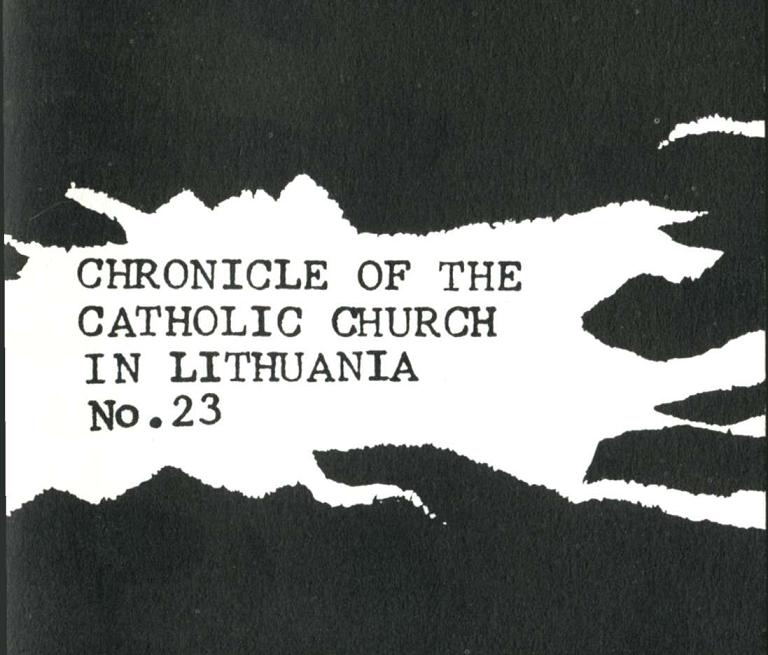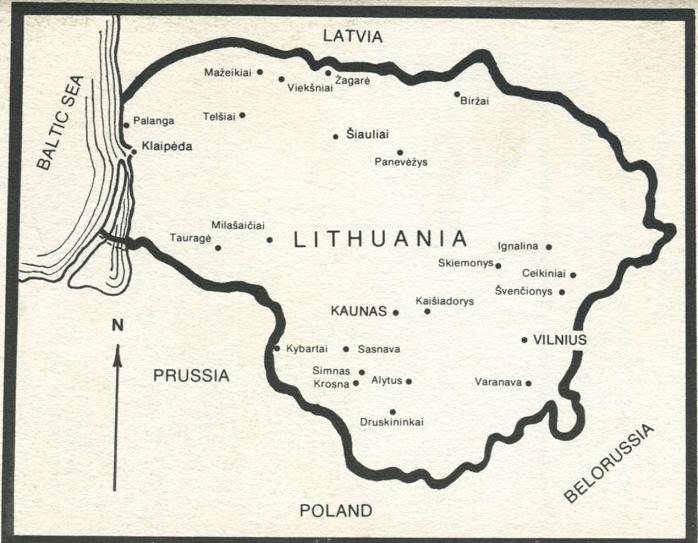CHRONICLE OF THE CATHOLIC CHURCH IN LITHUANIA No. 23 
A Letter to His Eminence Antonio Cardinal Samore and to His Eminence Josef Cardinal Slipij
A Petition from the Priests of the Archdiocese of Vilnius
Deputy K. Tumėnas Replies to Allegations
A Petition by The Rev. Karolius Garuckas
Letter of Vladas Lapienis to Secretary General Leonid Brezhnev
Appeal of the Faithful of Simnai
The Defense of The Rev. Juozas Zdebskis
NIJOLĖ SADŪNAITĖ IN PRISON CAMP
June 13, 1976

A Translation of the Complete Lithuanian Original, LIETUVOS KATALIKŲ BAŽNYČIOS KRONIKA No. 23 Documenting the Struggle for Human Rights In Soviet-Occupied Lithuania Today
Translation and publication of this issue made possible by a grant from the Lithuanian Roman Catholic Alliance of America.
Translation Editor: Rev. Casimir Pugevičius Published by the Lithuanian R.C. Priests' League of America 351 Highland Blvd. Brooklyn, NY 11207
©Lithuanian Roman Catholic Priests' League of America 1978 Printed by
Franciscan Fathers Press 341 Highland Blvd. Brooklyn, NY 11207
CHRONICLE OF THE CATHOLIC CHURCH IN LITHUANIA Nr. 23
Introduction
In 1940, when the Soviet Union occupied Lithuania by force, 85.5% of the country's more than 3 million inhabitants were Roman Catholic, 4.5% Protestant, 7.3% Jewish, 2.5% Orthodox and 0.2% of other persuasions.
In the two archdioceses and four dioceses were: 708 churches, 314 chapels, 73 monasteries, 85 convents, three archbishops, nine bishops, 1271 diocesan priests, 580 monks, of whom 168 were priests. Four seminaries had 470 students. There were 950 nuns.
Nuns cared for 35 kindergartens, 10 orphanages, 25 homes for the aged, two hospitals, a youth center, and an institute for the deaf-mute.
On June 15, 1940, the Red Army marched into Lithuania; the independent government was replaced by a puppet regime.
On July 14-15, rigged elections were staged. On July 21, with the Red Army surrounding the assembly house, the new People's Diet "unanimously" declared Lithuania a Soviet Socialist Republic.
On June 25, 1940, the Church was declared separate from the state, and the representative of the Holy See was expelled.
Parish lands were confiscated, clergy salaries and pensions were cut off, and their savings confiscated. Churches were deprived of support. Catholic printing plants were confiscated, and religious books destroyed.
On June 28, 1940, the teaching of religion and recitation of prayers in schools was forbidden. The University's Department of Theology and Philosophy was abolished, and all private schools were nationalized. The seminaries at Vilkaviškis and Telšiai were closed, and the seminary at Kaunas was permitted to operate on a very limited scale. The clergy were spied upon constantly.
On June 15, 1941, 34,260 Lithuanians were packed off in cattle-cars to undisclosed points in the Soviet Union. After World War II, the mass deportations resumed and continued until 1953.
Vincentas Borisevičius, Bishop of Telšiai, was arrested on February 3, 1946, and condemned to death after a secret trial. Before year's end, his auxiliary, Bishop Pranas Ramanauskas, was also arrested and deported to Siberia. Bishop Teofilius Matulionis of Kaišiadorys and Archbishop Mečislovas Reinys of Vilnius were deported to a Siberian labor camp. Archbishop Reinys perished in prison at Vladimir, November 8, 1953. By 1947, Lithuania was left with a single bishop, Kazimieras Paltarokas, of Panevėžys. He died in 1958.
In 1947, the last convents and monasteries were closed, their communities dispersed, and all monastic institutions were outlawed.
After Stalin's death in 1953, there was a slight improvement in the religious situation. Bishop Matulionis and Ramanauskas were allowed to return to Lithuania, but not to minister to their dioceses or to communicate with the clergy or laity.
Bishop Ramanauskas died in 1959, and Archbishop Matulionis in 1963.
In 1955, two new bishops were appointed by Rome and consecrated: Julijonas Steponavičius and Petras Maželis. Steponavičius has never been permitted to administer his diocese.
Bishop Vincentas Sladkevičius, consecrated in 1957, is also under severe government restrictions. In 1965, Monsignor Juozas Labukas-Matulaitis was consecrated in Rome to head the Archdiocese of Kaunas and the Diocese of Vilkaviškis.
Relaxation of pressure on religious believers soon revealed that the Lithuanian people were still deeply religious. It was decided in the mid-fifties to resume the attack. The principal means of attack would be unlimited moral pressure, since physical terror seemed only to strengthen and unify the faithful.
In 1972, the Chronicle of the Cathollic Church in Lithuania, clandestinely published in the country, began to reach the free world at irregular intervals. Primarily intended to keep Catholics in Lithuania informed of the situation of the Church there, these Lithuanian samizdat also serve as a constant appeal to the free world not to forget the plight of a people struggling against overwhelming odds to defend their religious beliefs and to regain their basic human rights.
Rev. Casimir Pugevičius Translation Editor










